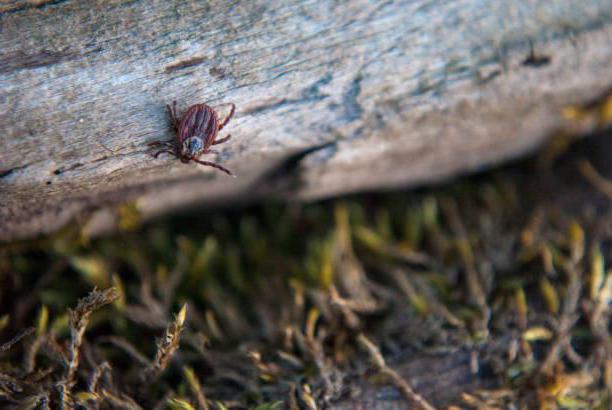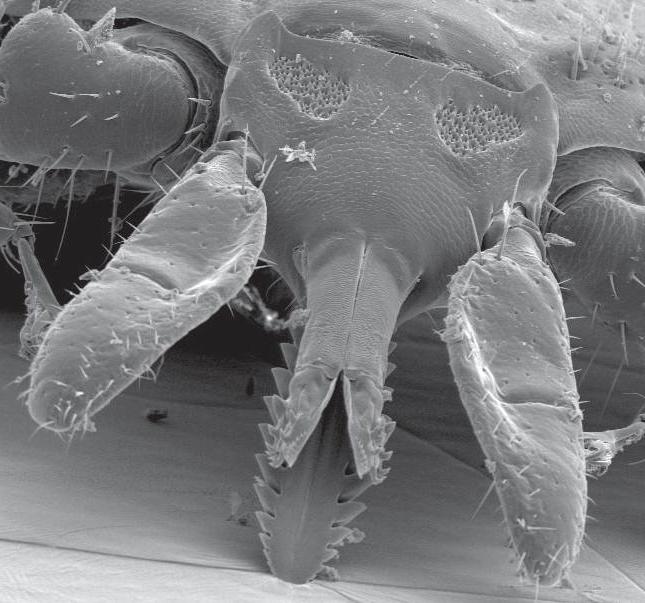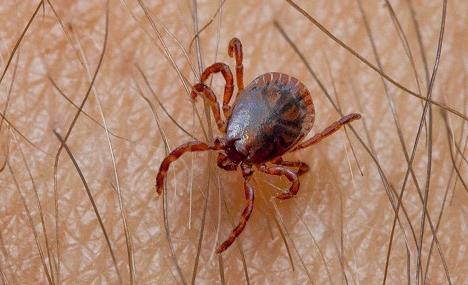The larva (nymph) of the tick: how it looks, is it dangerous for humans
Ixodes ticks are carriers of dangerousfor the human life of pathogens such as encephalitis, typhus, borreliosis (Lyme disease), erlichiosis and many others no less terrible. According to statistics, every sixth tick is infected with these viruses.

Stages of development
Ixodid mites have several stages of development - from the egg and to the adult, which directly depend on their nutrition. For all life, the tick takes food only four times. Stages of development:
- Larva: The shell is thin, sometimes translucent, but depends on the degree of filling with blood, the size - up to one millimeter. A distinctive factor is the presence of three pairs of legs (the adult has four of them) and the absence of a genital opening. Also, in the mite larva, the front part of the calf is covered with a dorsal shield. These are compacted segments of chitinous mite cover. When the larva is full of blood, and this takes from three to six days, it falls into a stage of rest (like a pupa in butterflies), during which it passes into the next stage.
- Nymph of the tick. If the larva is a child, then the nymph is a teenager in the world of ticks. In size it is larger, already up to two millimeters in length, more mobile when moved and has an almost formed reproductive system, but without an outlet opening. The nymph of the tick has four pairs of legs. Given that ticks live about two years, most of them winter during the nymph stage.

- Imago is a mature adult mite. From a nymph to an adult, the mite becomes again after complete satisfaction of hunger: after drinking blood, it begins transformation in the definitive stage and, having finished it, looks for a partner to complete the most important mission - mating and laying eggs. Hungry adults have a size of 6-8 mm, and fed and filled with blood can increase to three centimeters.
Photo of a nymph
What is dangerous for a person? At first glance it is hard to believe that in these two millimeters there can be a terrible defeat of the human brain - encephalitis. What does the nymph tick look like. shown in the photo below. Remember and be careful in the summer when this parasite is most active.
How to distinguish a nymph from an adult mite?
Looks like a nymph mite, as an adult, onlythree times less than the diameter of the body. There are no other differences visible to the naked eye, although some individuals may differ slightly in color: they are slightly lighter than their older relatives.

Where does this parasite normally live?
The fact that mites and nymphs jump on a person withtrees, are fictions, invented by people uninitiated in particular the life of the parasite. Most of his life passes in the grass or low-growing bushes, where he gets on a person's clothes, pet hair or other "vehicles." No mite is able to climb out on its own tree for the rest of its life and from there specifically jump on a person in search of food. If you were lying or sitting on the grass on a picnic or hiking in the forests, then, of course, there is a greater chance that the mite or his nymph will be hooked by the hooks behind the villi of clothes and creep onto the body in search of a gentle place for bite. Nymph tick usually parasitizes only in summer, and adults - from spring to autumn, especially actively showing themselves from May to August. A hungry mite can wait for its victim for more than a year and a half.
Is the mite a nymph dangerous?
For man, this stage of the parasite is dangerous,as well as an adult. The only difference is that it is difficult for a nymph to get on a person's body (unless, of course, he has been lying on the grass for a long time), for the reason that in the initial stages of development the mite lives in close proximity to the soil, days or winter in the cold season. To get on a tree or a big bush, he physically can not because of its meager size.

Can a creature with a size of 1 mm overcomedistance of at least 15 meters? Hardly. The larva (the first stage after the egg) is practically safe for humans: a parasite is unlikely to get on the body of a carrier, it has to be content with small rodents living near the ground. Moreover, the saliva of the larva is sterile and can not tolerate viruses. Is a nymph of an ixodic mite dangerous, which has already sucked blood from another? No, she is preparing for the next transformation, so her tasks are completely different, and the full belly is unlikely to demand an addition.
Can a nymph carry encephalitis?
Ticks of any kind related to ixodial(a family of parasitic forms), is the carrier and distributor of all the viruses that it carries on its body. A nymph, as already known, has the same degree of infection as an adult mite. Accordingly, it can also through a bite infect a person with dangerous diseases.

The virus that causes disease is transmitted from the nymphmites to a person through the saliva of a parasite and quickly spreads through the body due to the circulatory system. If you are bitten, you need to act quickly and purposefully.
What to do?
So, what if you were bitten by a tick nymph? This is very rare, becausethis stage of development of the tick does not allow it to rise above the grass. If suddenly it was discovered that the nymph had already attached, then firstly cover its body with vegetable oil. The respiratory tract at the mites is located on the abdomen, the oil will close these holes, and the nymph will have to look out for it in a few minutes. Gently pry her with tweezers and remove.
If an adult has sucked, then alsotry to manipulate with oil. Well helps the melted paraffin from the candle: the abdomen of the insect is filled with hot paraffin and wait a few minutes.

Another method of getting rid of the sucking imago- Lubricate it with kerosene. This will make him move and loosen the bite. Carefully grabbing the tick with tweezers and making light rotational movements in different directions, remove the parasite. In any case, we must turn to the medical center, taking with them a body of nymphs and mites for research in the laboratory for the presence of dangerous viruses. It is recommended that the bite site be treated with iodine for several days in a row - 3-5 times per day.
Signs of infection
If, some time after the bite orextracting a tick, a person feels a temperature rise, accompanied by chills, nausea, headache and a general decline in strength, it is absolutely necessary to go to the emergency room and explain the situation. Most likely, one of the viruses has already penetrated into the body and began a destructive effect. The sooner the measures are taken, the easier the consequences will be.
Means for protection against nymphs and ticks
Ways of personal protection against parasites of this kind are fairly simple and accessible to everyone. Adhering to them, you can freely move around any terrain, without being afraid to be bitten or infected:
- If you are going for a walk in the forest, it is better to wear light clothes (so it's easier to notice the tick) with long sleeves, pants to put on socks or boots.
- Use repellents (sprays, lotions and aerosols) against ticks, applying them to clothing, following the instructions in the manual.
- If there is an individual intolerance to synthetic drugs, then you can use essential oils of cloves, rosemary or mint. We put them on clothes or open parts of the body.
- Ticks can not tolerate the smell of marigold, lavender and geranium, so you can pick up a few plants and put them into their pockets.
- On return, you must carefully review your clothes and body for the presence of nymphs or attached ticks.
- If the work is associated with a long stay in the forests or other places of congestion of ticks, it makes sense to vaccinate.

Many rumors about the danger of encephalitisexaggerated because of ignorance of the main person: the bite of a mite nymph is not 100% infection, but only the probability, because only one-sixth of all mites and nymphs carry the infection. Observe the precautionary measures and do not focus on the bad, because as they say: "Wolves are afraid - do not go into the woods".
</ p>




